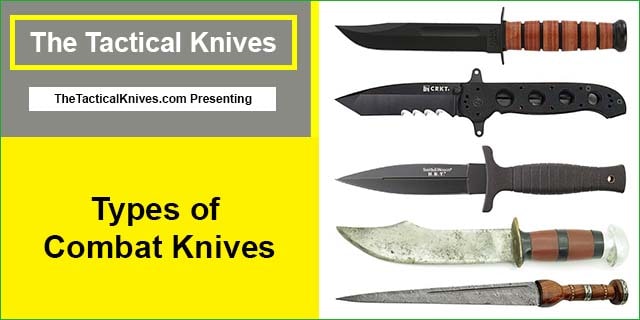There are a lot of combat knives that exist, but how many of them were originally used for combat purposes?
When thinking of combat knives, we assume that combat knives were always used for combat, but many were first invented for other purposes. Through time, these knives have evolved to include combat as one of their main purposes.
The following article discusses several different types of combat knives and both their history and how they’re currently used.
What Is A Combat Knife?
A combat knife is as it sounds, a knife designed to be used in close combat or hand-to-hand knife fighting. The first “close-quarter combat knife” issued for combat came out in 1350 and was mainly used by military personnel.
Over time combat knives have evolved to also become “fighting-utility knives” or a tool. Which sparked the international spread of combat knives and into many civilian homes.
What Makes A Good Combat Knife?
Since combat knives are designed for fighting, they must be able to be discrete, and safe, while also able to easily stab and slice.
The specifics of a combat knife will vary depending on how someone plans to use it; nevertheless, a good combat knife should be sharp, sturdy, easy to equip, and have a finger groove or quillon to prevent harm to yourself. It should also be easy to conceal and not shiny to not give it away when one is carrying a knife.
These features not only keep one safe but also make emergency combat easier.
Most Popular Types of Fighting Knives
- Tactical Knife
- Machete Knife
- Bowie Knife
- USMC Fighting Knife
- Dagger Knife
- Karambit Knife
- Kukri/Khukuri Knife
- Bayonet Knife
- Boot Knife
- Neck Knife
- Trench Knife
- Theater Knife
- Dirk Knife
- Navaja Knife
- Stiletto Knife
- Ballistic Knife
1. Tactical Knives
As mentioned, with time the definition of combat knives has grown to include being used as a tool instead of just combat, the specific name for this type of knife is a tactical knife.
Tactical knives are either fixed blade knives or folding knives.
Fixed blade tactical knives don’t bend and have a separate sheath to cover the blade. Some examples of the best small tactical fixed blade knives are Karambit, Boot Knife, and Neck Knife as well as large fixed tactical knives are Kukri, USMC, Machetes, and Bowie Knife. However, the average size of these knives is 5-7 inches in blade area and 9-12 inches overall.

Folding tactical knives are knives that have a pivot and locking mechanism and fold into the handle. Some of the best tactical folding knives are CRKT M16 Big Dog, Smith & Wesson SWMP4LS, Spyderco Paramilitary 2, Cold Steel Recon 1, SOG Escape, and Zero Tolerance Tiger Striped. The average size of tactical pocket knives is 2-4 inches in blade area and 6-9 inches overall.

Tactical knives can also vary when it comes to blade edges; some are plain or serrated blade edges and others have a partially serrated blade or combo edge. Read More: Best Partially Serrated Folding Knife
This variety in knives is what made the tactical knife so important to soldiers, as it gave them a tool to survive the harshest conditions and a weapon in case of an emergency. It is for the same reason that some of the good tactical knives have found their way into the homes of many civilians.
A tactical knife’s design allows it to be used for self-defense, hunting (skinning, gutting, etc.), fishing, camping, and basic survival. The tactical knife is wonderful, and every home should have at least one.
2. Machete Knife
A lot of combat knives are quite well known by the general public due to the media, an example of this is the machete.

As seen in several adventure movies, a machete is a long, fixed combat knife. The blade of a machete can be up to 12-18 inches and a total of 17-23 inches long and can come in different styles, which each type of machete differing in the shape of the blade.
Machetes have two areas of use, agriculture, and fighting.
When it comes to fighting machetes are a reliable knife, as they have been the tool of choice for many uprisings.
While machetes can slice, they are better at chopping brush, which is why they are popular in agricultural work. Being able to harvest crops, maintain trails, and chop compost makes the machete a reliable knife for blue-collar workers.
You May Like: Machete vs Bowie Knife – Which is Best for Fighting?
3. Bowie Knife
The Bowie knife is another popular combat knife, named after Jim Bowie, the Bowie knife is a fixed combat knife. Its blade measures from 5-12 inches and 10-17 inches in full length.
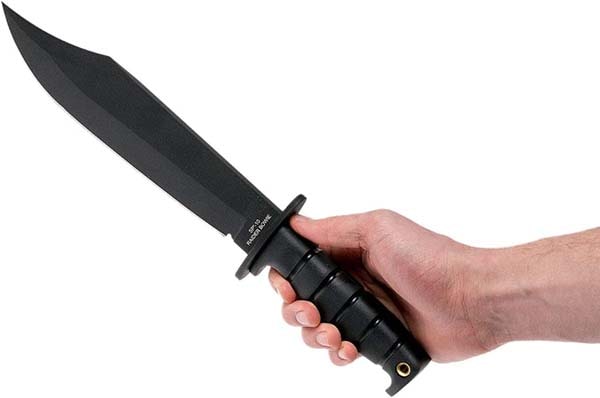
The Bowie knife that is known today was first designed in 1830, however, there were several prototypes of the Bowie knife made. Jim Bowie, the inventor, and designer of the Bowie knife was inspired by Spanish folding knives, specifically the clip point.
One day Jim Bowie used his one of the kind knife, and the fight was so immensely brutal, that the knife was dubbed the “Bowie knife”. More details on my “History of the Bowie Knife” page.
The Bowie knife is truly a fighting knife, specializing in combat/defense and hunting. The clip point makes the knife stab with ease, while the length of the blade helps hunters to better cut, skin, gut their prey and even chop wood. Most of the good Bowie knives are the go-to combat knives for hunters who spend days in the forest.
4. USMC Fighting Knife
Also known as the Ka-Bar, the USMC fighting knife is the best Ka-Bar military knife a deployed soldier can have. Most USMC knives have a blade length of 7 inches and an overall of 12 inches.
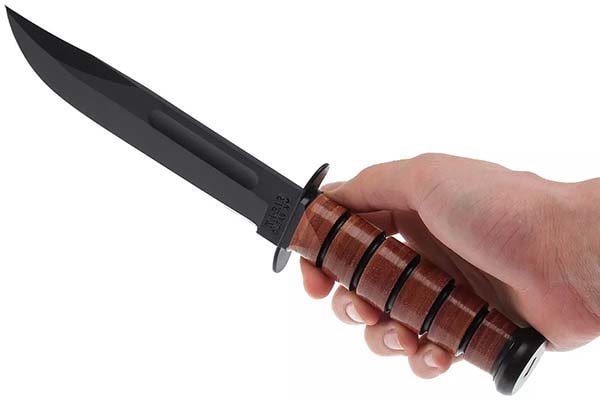
The USMC was made for members of the United States Marine Corps as they felt their current combat knife wasn’t what they needed. They needed a knife that could fight and be a tool, in 1942 they got that.
While the USMC fighting knife looks similar to a Bowie knife due to the clip point, the grooved leather handle is what sets the USMC apart. These grooves allow for a tighter grip on the knife in dusty or wet conditions, something quite important when facing harsh conditions.
When it comes to combat knives, the USMC fighting knife is THE soldier’s knife.
5. Dagger Knife
Despite being one of the most well-known fighting knives around the world, there is still a lot about the dagger that many don’t know.

For instance, there are two types of daggers, fixed blade daggers and push daggers.
Fixed blade daggers are the more common type, they’re seen in movies and even the game CLUE. A fixed blade dagger is 5 to 12 inches long and like many other combat knives, is primarily used for close combat. While fixed blade daggers are typically longer than push daggers, they both have spear tips.
You Make Like: Top Rated Fixed Blade Knives Under $200
Push daggers are also fixed blade knives but on a much smaller scale. The modern push dagger dates back to the 19th century, about 3,900 years from the modern fixed blade dagger. It isn’t clear why the push dagger was first invented; however, the knife became popular as it was a reliable self-defense weapon.
The small size and curved handle made the knife easy to hide and use. Despite being visually different, fixed blade daggers and push daggers come together as reliable weapons for close combat and defense.
6. Karambit Knife
Originating in Indonesia (and Malaysia) and traditionally being used for harvesting crops, the karambit has recently had a boom in popularity. A karambit knife has a blade length of 3 to 5 inches and a total length of 7 to 9 inches.
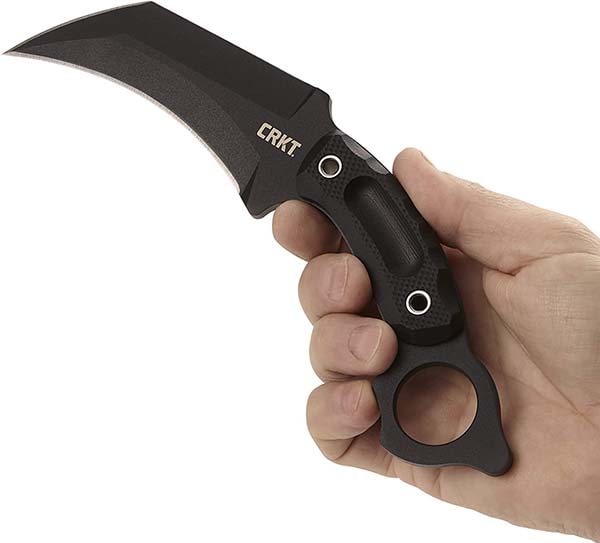
Originally the karambit was seen as a weapon only if there were nothing else, so it’s quite peculiar how the knife became a recognized combat knife.
What makes the karambit unique is the curved blade, and safety ring, while there are many variations of karambits, each one has a curved/hooked blade and safety ring.
Karambits are relatively easy to conceal, with some being folding knives, and the safety ring prevents the user from accidentally cutting themself.
Nevertheless, karambits can still be used as utility knives as they can cut through rope, nylon, and other heavy-duty fibers with ease. Regardless of use (self-defense or utility), karambits are sure to make an impact.
7. Kukri Knife
Despite being mistaken for a type of machete, the kukri is anything but a simply fixed blade knife. Named the national weapon of Nepal, the kukri knife has a rich history.
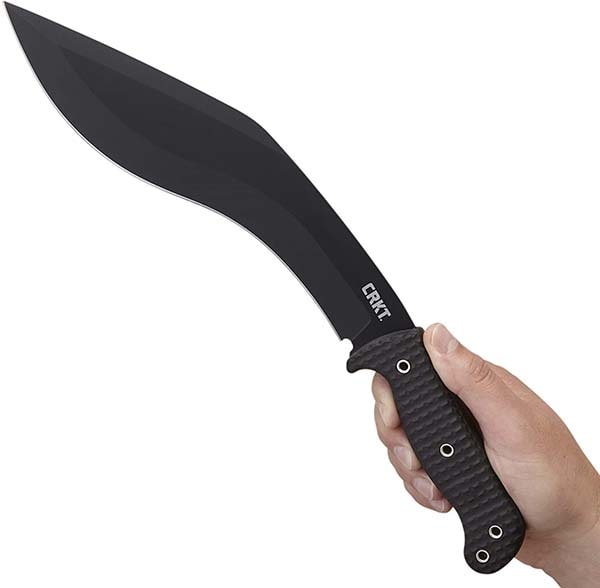
The modern kukri knife was first recorded in the 17th century, this knife was originally designed after sickles. Many farmers in Nepal used kukris as a general tool, something to harvest crops or slaughter animals.
However, this 15-20 inches overall and 10–15 inches bladed knife became popular through being associated with the Gurkhas. The Gurkhas are Nepali soldiers known for their formidable nature and military prowess. Each Gurkha would receive at least one kukri knife, with some stories saying they would mark the knife with their blood as a fighting knife.
The kukri knife is a perfect example of how everything and everyone are more complex than they seem.
8. U.S. Military Bayonet Knife
When most hear the word “bayonet” they think of the blade that is attached to the muzzle of a gun, a bayonet knife is similar in that it is a (6-9 inches blade and 10-14 inches overall) tactical knife that can be used as a knife or as a bayonet.
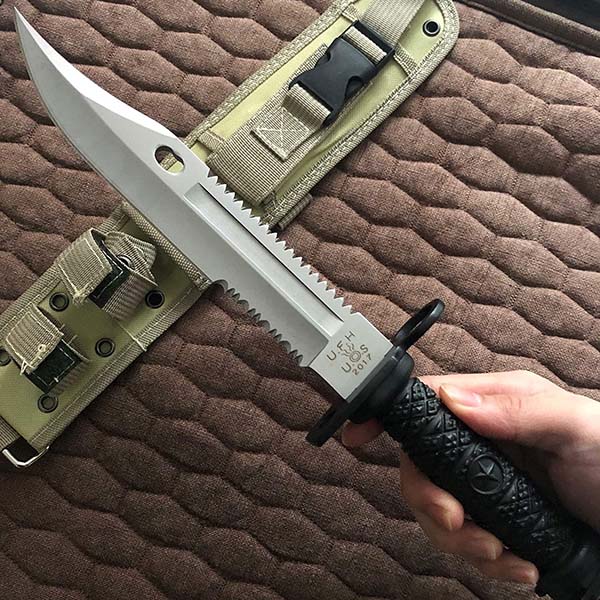
Bayonets have been around since the 17th century, but with modern warfare, bayonets were used less and less. This sparked the invention of the U.S. Military bayonet knife, a knife that could be used separately as a tool or as a weapon but could still be attached and act as a bayonet.
Having a bayonet is still important for when an enemy closes the distance, and one must quickly switch from ranged combat to close combat. By using a bayonet in close combat instead of another knife, the soldier is also able to keep some distance.
Despite this many don’t use bayonets, proving bayonet knives to be more useful in allowing soldiers to choose to use their weapon like a knife or bayonet.
9. Boot Knife
A boot knife is a popular small fixed blade knife that is designed to be concealed and carried within one’s boot, while not a specific type of combat knife, boot knives are commonly small daggers.
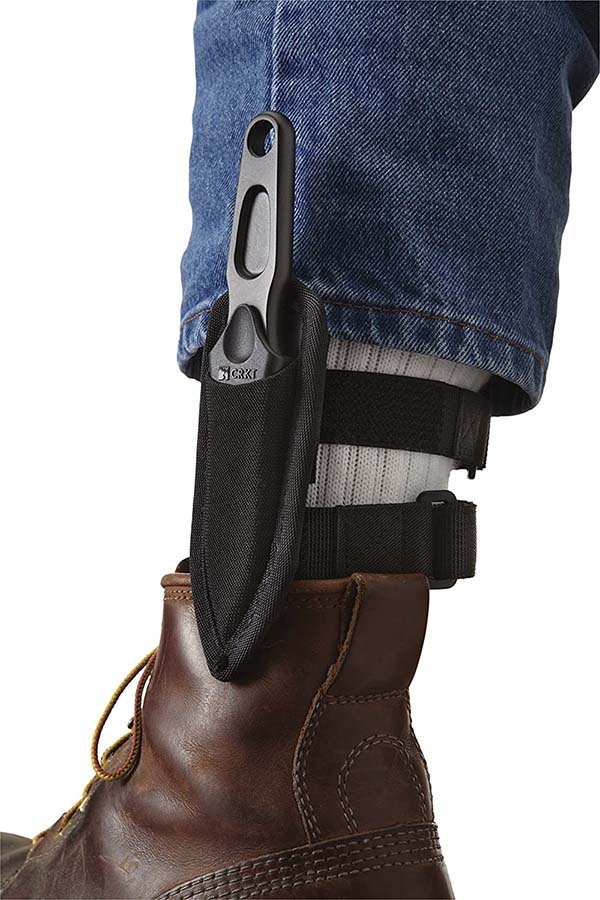
Boot knives became popular in the U.S. at a time when violence was a common occurrence, so people needed a knife they could carry and use if needed.
Boot knives as mentioned were stored in boots by attaching a sheath to the boot itself. Since boot knives were meant to be concealed the average size of one is only 3 to 5 inches in blade length and 6-9 inches in total length.
Unlike many of the other knives mentioned, boot knives evolved in the opposite direction. The boot knife started out for self-defense but in modern times grew to be used for utility purposes as well. Many blue-collar workers carry boot knives when they are in a pinch.
10. Neck Knife
For those who want a knife similar to the boot knife but to carry it around their neck, there is the neck knife. Neck knives can be any knife worn around the neck but are usually a fixed blade with a blade between 2-4 inches and an overall length between 5-8 inches.
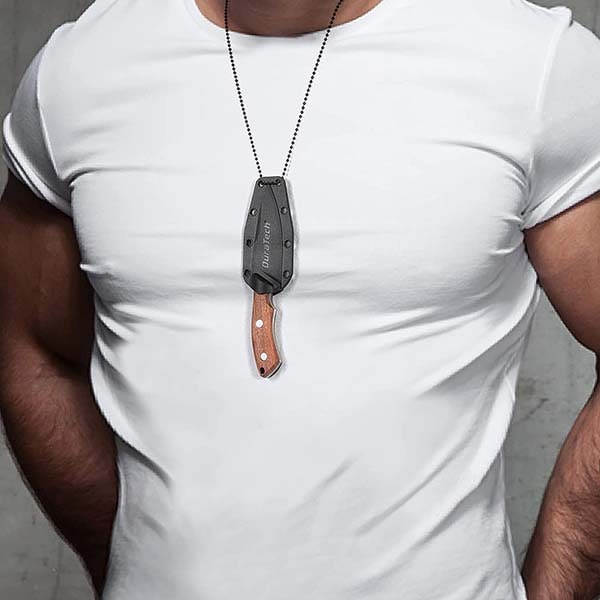
Unlike boot knives, neck knives tend to be more focused towards utility purposes and are the favored knife by backpackers as they are easy to carry and inexpensive. Neck knives can also be used for personal defense and may provide more reassurance than boot knives.
Neck knives are easily concealed due to their small size and their placement allows one to quickly draw the knife at a moment’s notice. When it comes to the rule: always carry a knife… even in the shower, neck knives rise to the occasion.
11. Trench Knife
Distributed to soldiers in WWI the trench knife (or knuckle knife) is a medium-sized knife designed for close combat. It has a blade of 5-8 inches and an overall length of 10-13 inches. In WWI, most of the battles were fought using trench warfare, soldiers rarely moved and mainly shot explosives at the other side.
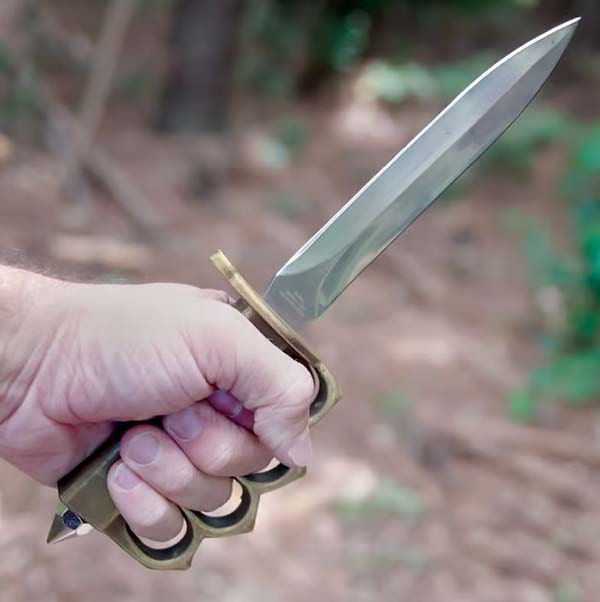
Nevertheless, soldiers needed a weapon for close combat in case someone entered their trench, thus the trench knife was invented.
Trenches weren’t the best conditions for soldiers to fight in, soldiers required a special handle for their knives. Trench knives were equipped with a handle that looked like brass knuckles, this allows for hand protection, and a better grip on the knife in case the enemy attempted to simply grab the blade away.
In the end, the trench knife was only ever made for combat, but its design made it extremely helpful for close combat.
12. Theater Knife
Perhaps one of the most unique combat knives is the theater knife. A theater knife is a knife that was made in a theater of war or an area that was directly involved with military operations. These knives usually have a blade between 5-8 inches long and the overall length of the knives is between 10-12 inches.
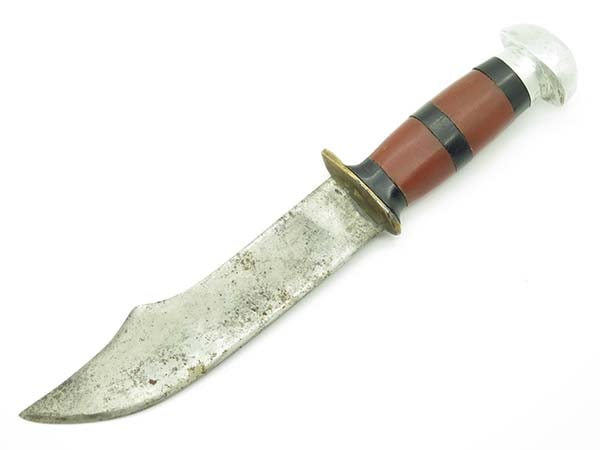
What makes these knives so unique is that no two knives are the same as these knives were made out of spare parts laying around. Some knives were completely made from scratch with parts lying around, others were just knives that were modified.
Theater knives were also unique in that they were not meant to be used for combat. Soldiers made these knives as a form of art and a way to pass the time. While theater knives could be used for combat or tactical purposes, they were mainly an efficient activity for bored soldiers.
13. Dirk Knife
Measuring 12-15 inches in the blade and overall 17-20 inches long, the Dirk knife is the longest dagger out there. Dirk knives were favored by Scottish Highlanders as they were just as formidable as a steel sword but not as expensive.
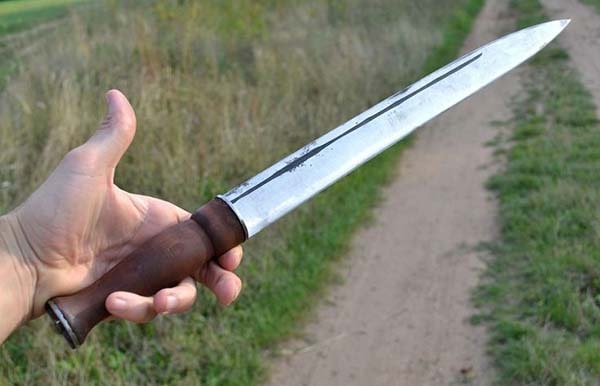
Soldiers mainly used Dirk knives as a weapon for close combat and stabbing, which is reflected in the blade design. Dirk knives have a thin spear tip allowing them to pierce with ease, along with a blade edge on one side.
However, these knives were not designed to be used for utility purposes, and due to such the Dirk knife became less common to carry due to the invention of firearms. These knives can still be seen in collections or formal military attire, but sadly are scarcely carried for everyday use.
14. Navaja Knife
As mentioned prior, the Bowie knife was inspired by Spanish folding knives, also known as navaja knives. Navaja knives are dated back to the 17th century, but earlier designs may go back even further. The blade length of these knives was about 12-15 inches.
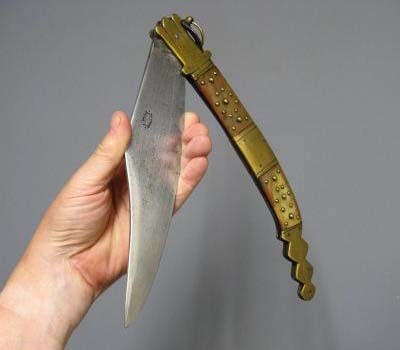
Navaja knives were popular among the poor; Spanish peasants used the navaja knives as a utility knife, and for tasks such as sharpening other tools. But, with time the navaja knife started to be used more for fighting purposes, the folding mechanism allows for users to fight with the knife and tuck it away in a pocket when done.
The navaja is also said to be the first folding knife with a locking mechanism. While not the first folding knife, the navaja is certainly a memorable folding knife.
15. Stiletto Knife
The stiletto knife is another folding knife that is similar to the dagger. The stiletto knife gets its name from the needle-like tip, which allows the knife to be extremely proficient in stabbing. The average size measurement of these knives is the blade length of 6 inches; the handle length of 7 inches and the opening length of 13 inches.
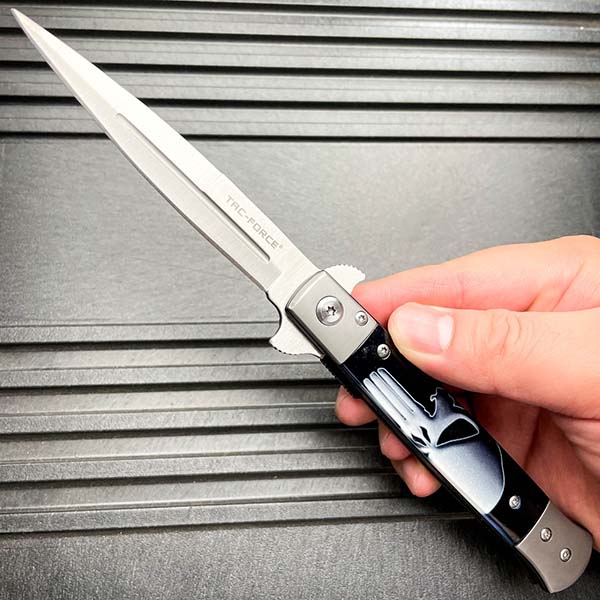
Stiletto knives were used to finish opponents off in the medieval ages but could also be used for self-defense. While the stiletto knife can be used for defense, it tests horribly at slashing and cutting.
The stiletto knife started as a fixed blade but over time it gained a spring mechanism allowing the knife to act similar to a switchblade. However, this spring mechanism makes the knife illegal to carry in many places. While interesting, the stiletto knife may not be the most reliable.
16. Ballistic Knife
Ballistic knives are neither folding nor fixed knives; these knives look like a fixed blade but have an internal mechanism allowing for the blade to be shot out. The spring mechanism allows for the weapon to be just as deadly as a gun but much quieter.
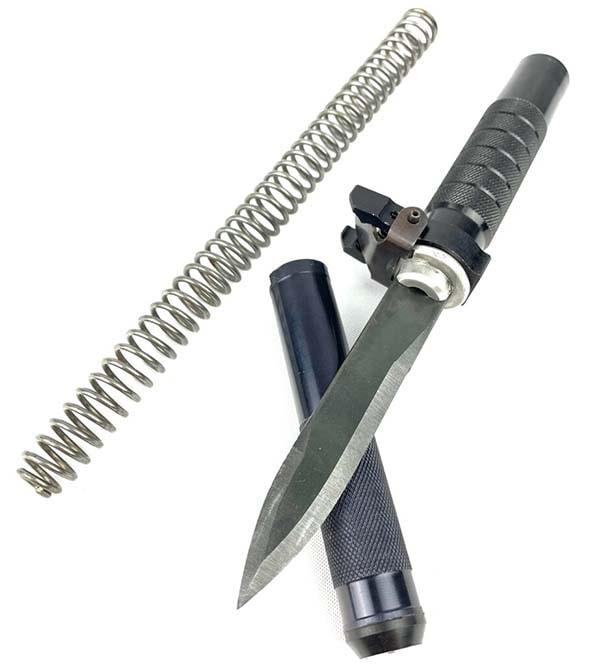
Ballistic knives were first used by members of the Soviet Union but traveled to America where they became quite popular. In America, most concealed knives are illegal to carry, as for the ballistic knife, it is illegal just to own.
While it is still possible to buy a ballistic knife, it cannot cross state lines or be carried out due to federal law.
Final Thoughts
Knives have been around since the dawn of man and have helped us in many different ways. They are versatile, changing with us, changing based on what we need most at the moment. Knives are like people; each one has a story.
